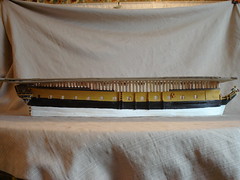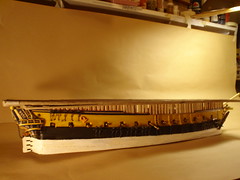
Just as the legendary comely face of Helen of Troy allegedly launched a thousand ships, so to serious modelers have launched a thousand tirades of disappointments at the high price and low quality of HECEPOB European sailing ship model kits.
My answer to this problem was to scratch build a model of the 30 gun French frigate, La Renommee (The Fame).
With the help of plans in 1/64 scale bought several years ago from the late Abe Taubman's plans service and down loaded pictures obtained on my computer from the web site, perso.wanadoo, of the French model maker, Marc Auboyneau, it was possible to make a reasonable copy of my model.

Designed and built by Clairin Deslauries, a protege of the renouned 18th century French ship designer, Blaise Ollivier, La Renommee was launched at Brest in 1744. Considered to be the fastest frigate of her day, due to her fine bow entrance, she could not carry cannons forward of the foremast, as it caused an unbalance weight distribution.
On May 10,1747, while stationed at the French Leeward Island of Guadelope in the Caribbean Sea, La Renommee was captured by the British 50 gun warship, Dover.
Taken to England, La Renommee was rebuilt to conform to Royal Naval specifications and renamed Renown. The Renown, ex-La Renommee, served 24 years under her new masters before she was broken up at the Woolwich Naval Dockyards in 1771.

This model was first built from sequential numbered wooden ribs cut by a scroll saw, as illustrated in the plans. These ribs were then secured to a jig in the up-side-down method as suggested for the plank-on-frame technique by the model builder, Harold M. Hahn.
After the ribs had been secured, a black wale is bent in place on the ribs. From this wale as a reference point, gun ports and deck levels are drawn on th ribs, by using a pair of drafting dividers to transfer the correct dimensions from the plan. When this procedure is completed, outside planking can be fastened while making sure gun ports are cut out in the proper place and the deck line is located. The model is then uprighted, the ribs are severed from the jig, decks are added, masting is centered and rigging is tied according to plan.

The completed starboard side is painted with acrylics after the gun ports are cut out and the deck line determined. The under water portion of the hull was made flat to attach on to an artificial sea. This short cut enabled me to avoid constructing the lower portion of the hull configuration.

In this photo, the jig that secures the numbered ribs is seen. The main deck is put in place and an orderly row of cannons is positioned. A mid-sectional arrangement of deck furniture with nested long boat and pinnace is added according to the plans. The three windows of the officer's wardroom is visable at the top of the picture.

The nested long boat and pinnace was made from Sculpey, a polymer modeling clay. The clay was molded on a wooden plug shaped like a boat, removed, and baked in an oven at 275'F for 30 minutes. After the boats were baked, they were painted with acrylics, seats and oars were added in place.
The two anchors are lead castings. The lead was scavenged from old auto tire weights. After casting, the anchors were sanded and painted black. Wooden anchor stocks were added later.

The bow of the La Renommee model. The cupid figurehead holding a globe was a difficult task to make. After four attempts of shaping the figure from Sculpey modeling clay to an acceptable likeness, the figure was baked, painted and set in place on the bow.

The stern with four windows of the officer's wardroom. The purpose of the chains on the rudder, was to prevent losing the rudder in the event the rudder became unhinged during severe weather conditions.
The ethereal figure of a cupid floating on a bed of clouds, was copied from the plan, painted and glued in place.

This is the draught of the Renown, ex-Renommee made after her capture by the Dover in 1747. It is from the collection of ships plans of vessels bought, constructed at the Royal Naval Dockyards or captured by the Royal Navy. These plans are housed at the National Maritime Museum at Greenwich, England. Copied from the book,"The First Frigates," by Robert Gardiner, page 11.
I'm going to put building the model of the La Renommee aside for the time being, to resume completion of a kit my wife gave me last Christmas.
Montani semper liberi ! Merry Christmas, Happy New Year and happy modeling to all and every one of you. Crackers